Texas Grid Regulators Have Recommended Winterizing Resources Many Times, No Requirements Though
As it turns out, the winter storm and historic outages in Texas have been predicted and warned against for decades. However there has been little regulatory requirement for utilities, generators, or grid operators to take action. Texas Was Warned a Decade Ago Its Grid Was Unready for Cold (yahoo.com)
I found this discussion on The Energy Gang podcast regarding the Texas outages to be enlightening. Of note this was Jigar Shah’s second to last appearance on The Energy Gang; he was hired by the Dept of Energy Loan Office, which is very good news for renewable energy companies trying to bridge the gap and scale their innovations up to market. https://www.bloomberg.com/news/articles/2021-03-03/jigar-shah-to-run-u-s-energy-office-that-backed-tesla-solyndra
Regarding the Texas grid failure, and its much less regulated grid, we will be learning much over the coming months, and it will be interested to see how those monthly electric bills work out for people. You can anticipate there will be plenty of greed and corruption on public display.
Our vision is to avoid the worst of what we saw in Texas by promoting clean renewable and distributed energy generation. The more grid-tied arrays are at the point of use, the better off everyone will be, not only the owners of those arrays saving money on their bills. Ultimately the entire grid will become more stabile and less reliant on centralized energy sources and those that control them.
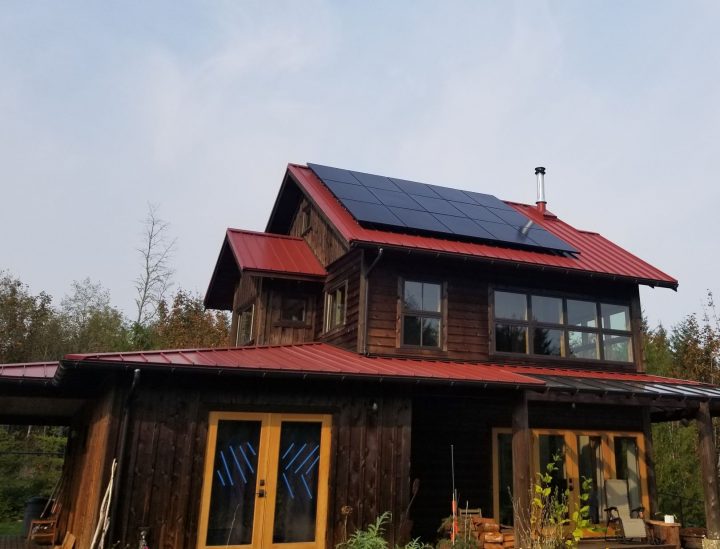
5 KW Sunpower array in Chimacum on Jefferson PUD Grid, July 2020
Lithium Batteries Experiencing Tremendous Growth in Market
Lithium battery production have been on a strong growth curve for many years and is poised for ten-fold increase development in the near term with support of the current administration and significant venture capital investments across the industry.
According to Gene Berdichevsky, CEO of Sila Nano, and formerly Tesla employee #7, there is currently about 285 GWh of annual production capacity for lithium batteries. He states there is an additional 2000 GWh of production capacity under development that will be complete within the next 5 years. Gene was recently interviewed by Shayle Kann on The Interchange. Sila Nano is itself building a plant that will provide anode materials for up to 100 GWh of lithium batteries annually targeted for the EV market, and sufficient for about one million vehicles per year. https://www.forbes.com/sites/alanohnsman/2021/01/26/sila-nano-hauls-in-590-million-to-make-materials-for-better-electric-car-batteries/
While we recognize there are issues with the procurement of lithium and other materials, there are groups addressing the issues currently, and it appears that the use of electric motors and lithium batteries is currently the best practice for all ground transportation, be it personal vehicles, freight, or rail.
Here at Power Trip and for all of us in Washington State, we are installing batteries, though there is still no economic impetus for batteries in conjunction with your solar array. While the percentage of our clients that initially state they want batteries is increasing, after we conduct an analysis of their energy needs, we usually determine the most sensible path is to install as much solar as possible up to the amount of energy you use, make certain you are using an electric vehicle as much as possible rather than buying and burning gasoline, and make other improvements in energy efficiency and emergency preparedness prior to considering a lithium battery installation.
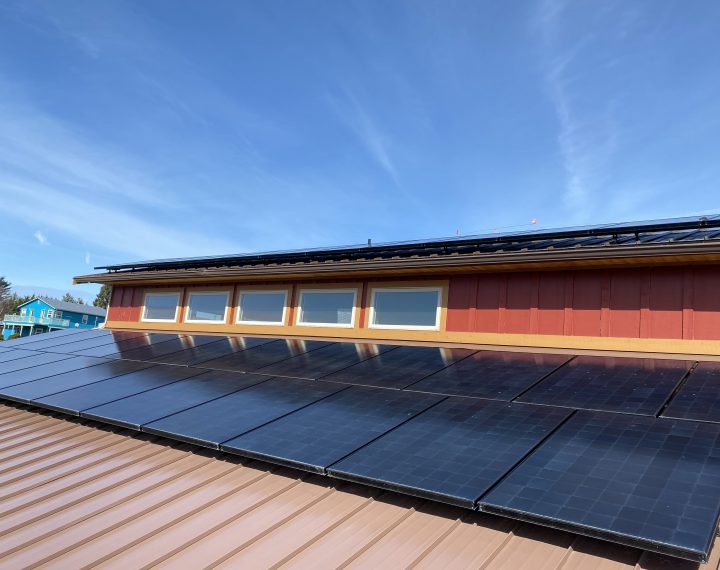
11.7 KW Sunpower array on barn, Sequim, WA
Solar Spring Enhanced by Sunpower $500 Rebate
We are happy to be able to offer a $500 from Sunpower on projects ordered by March 31, 2021. Rebate will come after project completion in the form of a pre-paid VISA card from Sunpower.
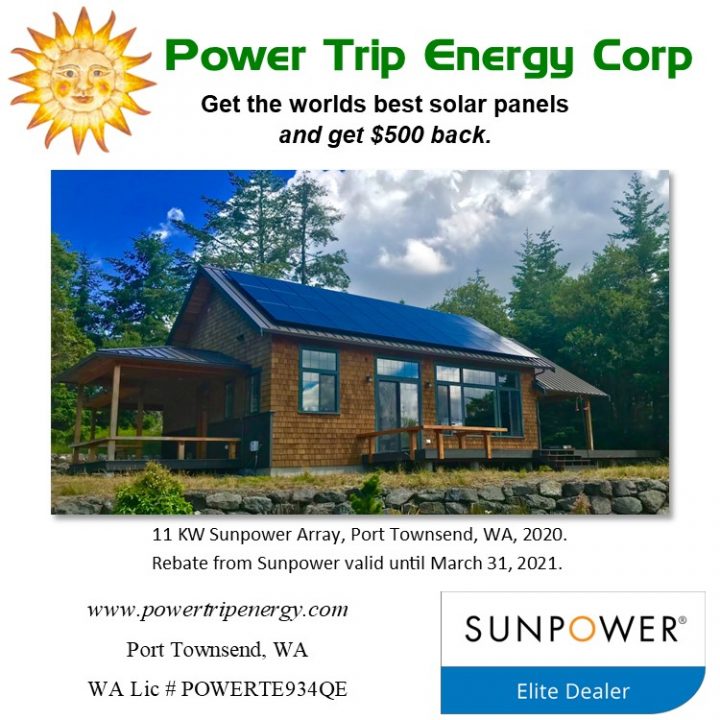
3/17/2021 Note – Some details: Available on New Sunpower Equinox AC systems, minimum size 2.8 KW.
The Texas Grid Experiences a Massive Failure – and Becomes Used By Those Trying To Tarnish Renewable Energy
The Texas grid has lost about 35 MW of production capacity during a severe winter storm, and this has caused cascading outages for millions of people across service territories. Texas is the largest energy producing state in the country. This article from GTM lists some of the reasons and some of the history since the last severe storms and outages there 10 years ago. I find GTM’s writing fact based and the right level of sophistication for my understanding and the time I have for issues in other areas.
https://www.greentechmedia.com/articles/read/texas-energy-system-faces-a-winter-reckoning
I send sympathy to people suffering the hardest, and I understand many people have perished.
I have also seen the fossil fuel industry and their spokespeople using this event as an opportunity to tarnish wind and solar energy generation. While natural gas, coal, and nuclear plant shut-downs have been responsible for twice as much of the outage as wind and solar plants coming off-line, some have still claimed this is an example of why we should not build more renewable energy plants. It turns out not to be true.
https://abcnews.go.com/US/wireStory/texas-blackouts-fuel-false-claims-renewable-energy-75936319
We should pursue both utility scale and distributed generation of renewable energy sources, which will provide more reliability in the long run, and will reduce our contribution to greenhouse gasses and anthropogenic climate change, which appears to be contributing to greater and more unpredictable weather events, often in areas not accustomed to them, like Texas.
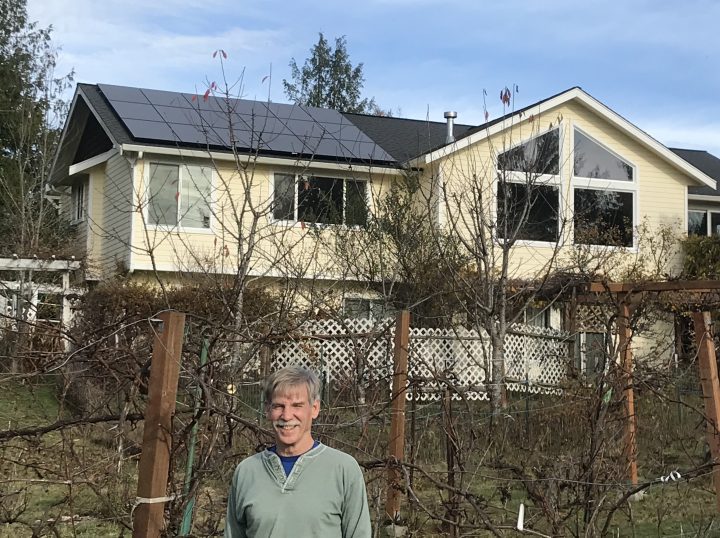
6.3 KW of Sunpower on the roof, on the Jefferson PUD grid in Port Townsend

Solar Spring 2021
As we begin our 19th year, we want to continue to support solar here on the Peninsula through this special offer.
Solar Tax Credit is Extended – Remains 26% for Two More Years
As part of the $900 Billion COVID Relief Bill that was passed and signed at the end of December, the item that will most immediately affect our clients this year is the extension of the 26% ITC (Investment Tax Credit.) It has been slated to decrease to 22% this year and expire next year, however we now have the 26% for this year and 2022, then 22% for 2023, then expiration.
SO – if you have been considering solar for your roof, there has never been a better time than right now!
There were other clean energy related aspects of the bill, and several policies that solar advocates have been working for that still need to be worked towards with the next administration. Green Tech Media provides a nice summary here https://www.greentechmedia.com/articles/read/what-renewable-energy-and-energy-storage-did-and-didnt-get-from-congress-this-week
We are looking forward to a very positive, very sunny year, and working hard every day to install as much local clean solar for our clients as possible. Happy New Year to all.
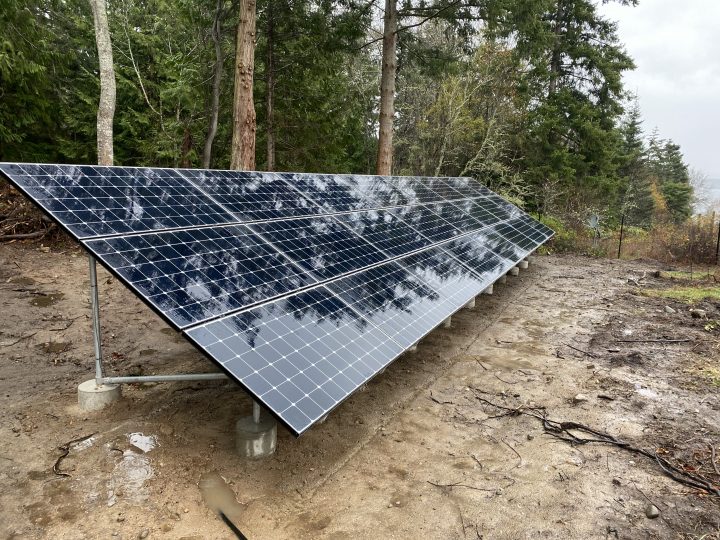
10 Kw Ground Mount, November 2020
Year-End Rebate Available from Sunpower
We have been Sunpower dealers for over 10 years now, and we are happy with this partnership. Sunpower has navigated the changing solar industry with aplomb, and we are confident in the quality we are providing for our customers with this product. Their 25 year warranty guaranteeing 92% power output leads the industry.
Promotions and any savings are nice, though the reason we work with Sunpower is because of the high efficiency, long-term reliability, and the stability of the company. Sunpoower is not generally big on promotions, however they are offering homeowners a $1,020 manufacturer’s rebate in the form of a VISA Reward Card through year-end. If you have been considering installing a solar pv array on your home, this may be the news you are looking for to call you to action.
Promotion Details
- Promotion available until December 31, 2020.
- Homeowners are eligible for a $1,020 manufacturer’s rebate in the form of a VISA Reward Card.
- Customers must sign a purchase or loan agreement by midnight on December 31, 2020.
- System must be deployed by March 26, 2021.
- This offer is only valid on SunPower Equinox® AC systems.
- Minimum size systems of 2.8 Kw
- Cannot be combined with any other SunPower promotions
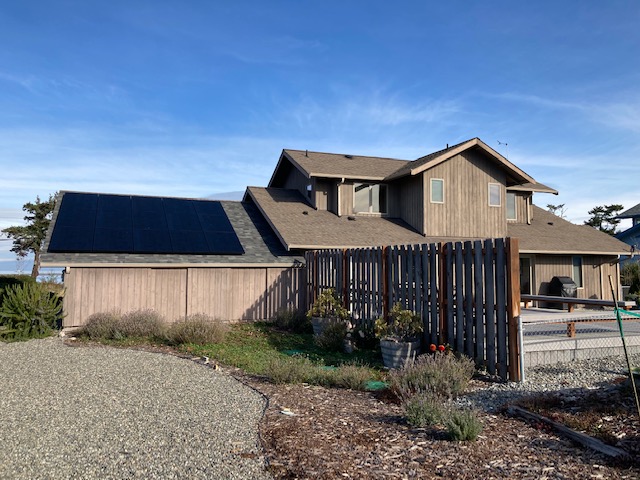
5.25 KW Sunpower pv array on Clallam PUD grid in Sequim, Sept 2020
80% of Americans Can Not Install Solar on their Roof. Are you a member of the 20%?
This statistic in itself is not new, and Solstice arrived at this number using simiilar methodolgy I have seen used to yield similar results in the past. They are considering homeownership, shade vs solar resource, credit worthiness, and local regulations. Credit to their article, link is here – https://solstice.us/solstice-blog/why-americans-cant-access-rooftop-solar/
Our original quick and easy estimate of houses with roofs that could install solar on the Olympic Peninsula came from our friend Jake Wade, who used to work for PSE. He guessed that 1/3 of the homes were owner-occupied by people with good credit, and that 1/3 of the homes had a good sunny roof – yielding 1/9, or 11% of homes here being good candidates for solar arrays. Other estimates often yield a slightly higher potential percentage. Currently in Jefferson County, about 2% of all electrical meters are net metered, indicating we could increase the number of solar arrays by a factor of 5 to 10 times, and that is our goal.
Community Solar in WA – past and future
For the remaining ~80%, many people support the idea of Community Solar. This is a structure in which many people buy shares of a large array, and get the proper credit on their electric bill, the benefit of whatever portion of the larger array they own. Community Solar has seen a couple of iterations so far here in Washington State, neither of which was easy to put together. We installed two such projects, one of which we developed ourselves, with a team of fantastic partners, all figuring it out as we went, hoping to develop a project design and manual that others could replicate. While the project itself was a success (if we don’t count only dollars and not the time and value of countless hours of work on development, we will count that as education), we did learn that we didn’t think the laws and programs in place at the time supported healthy community solar projects, so did not accomplish our goals of developing a replicable project. The second project was installed for Clallam PUD, and was their baby, well-executed. We just helped promote a bit, and performed an inexpensive, efficient, aesthetic installation.
At this point, to my understanding of what is in place at the state level, any utility could develop a community solar project any time, and design the program and pricing as they see fit. There are no special state incentives at this moment, and utilities are mainly tasked with providing reliable and inexpensive electricity, and they really focus on that which they should. So it is not a surprise to me that we don’t see utilities developing new community solar projects at this moment. There will be new and improved legislation proposed in Olympia in the spring, and this moment will require ingenuity to find positive paths towards some economic recovery – just exactly what is available in community solar programs. We will let you know more about those efforts soon as they firm up.
Today – Solar for your Home
In the meanwhile, if you are one of the 20%-ers that has a good sunny roof on a home you own, and sufficient funds or credit to make this investment in your home, there has probably never been a better time to make that investment in solar. There is a 26% federal tax credit available through the end of the year, next year it becomes 22%, and then gone after 2021. In times of uncertainty, we know the sun will rise tomorrow and that investments in your self and your home are a safe and wise choice.

11.7 KW – Bremerton Residence – 2019
Rebuilding the World We Want – Clean Safe Infrastructure
Globally, we are experiencing a significant disruption to the economy to which we had become accustomed, due to our response to the COVID-19 pandemic. While the questions remain as to if and how we should go about resuming our previous businesses and consumer habits, we can view this moment as a great opportunity. At an individual level, many people have expressed appreciation for the opportunity to leave behind some old habits, and embrace some of the aspects of life that have been foisted upon us, but which we find fulfilling. Spending more time with family, working on our homes and in our gardens, and less time spent commuting are all some positive results that some people have experienced in the last several months.
As a country, we have not been taking care of many things, including our transportation infrastructure as well as we could have, and as a result, we find many bridges and highways are old and in poor condition. We need to perform many seismic retrofits as we now better understand the dangers of earthquakes, and have better materials science available to us to build more resilient structures. Many of our public buildings are aging and inefficient, and present great opportunity for us to re-invest in improvements which will result in greater energy efficiency and improved indoor air quality.
We also need to address our carbon emissions, and we are now in the position to greatly improve the cleanliness of our transportation and public infrastructure through electrification and clean renewable energy sources, mostly solar. In our buildings, we will leave behind fossil fuel-based heat sources, and utilize highly efficient and clean electric heat pumps, in addition to improved insulation and windows, and greater understanding of passive solar opportunities to decrease energy needs and improve the quality of the work and living spaces inside.
Regarding transportation, we continue to see Electric Vehicles increase in the personal transportation market, and we are on the verge of seeing larger segments of the transportation market be addressed by EV’s – notably school buses, garbage trucks, and delivery vehicles (Amazon, UPS, and Federal Express). These vehicles are ideal for EV technology since the start-stop nature of their driving maximizes the benefits of regenerative braking, wherein re-routing kinetic energy to battery charging slows the vehicle. The retirement of our country’s diesel school bus fleet would be especially beneficial to our kids as it would decrease their exposure to harmful diesel emissions and particulates.
In summary – this is our opportunity – to invest in clean infrastructure and transportation by using the massive economic power of the federal government, which creates good jobs to assist with our economic recovery, and improves the environment and public health for generations to come by decreasing pollution and carbon emissions.
We urge you to let your representatives know that these are important decisions you want made on your behalf. Please support candidates that understand and agree with these goals.
While our individual influence over the state and federal government policy may be frustratingly limited, the decisions that you do have within your control are regarding your own home and vehicles. You may wish to consider a sensible EV for your personal transportation, and placing solar panels on your sunny roof to create clean local renewable energy.

8.4 kw Sunpower array on garage, Sequim, March 2020
Clallam PUD Commissioner Waddell gives voice to those critical of Lower Snake River dams
Commissioner Waddell has made waves in stilled waters. By questioning the goals and claims of a power industry trade organization which the Clallam PUD has long supported, Waddell has alienated the leadership of the Public Power Council and caused the expulsion of Clallam PUD from the group, incidentally saving the ratepayers the $22,597 in annual dues for this year. Waddell has pointed out that there may be benefits to the removal of the four Lower Snake River dams through his involvement with Dam Sense, www.damsense.org.
Here in Jefferson County, our PUD is a current member of the Public Power Council, whose goal is the preserve and enhance the benefits of the Federal Columbia River Power System for it’s member utilities.